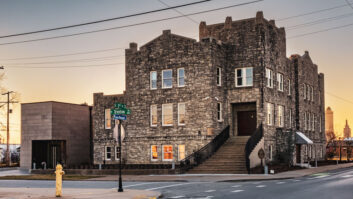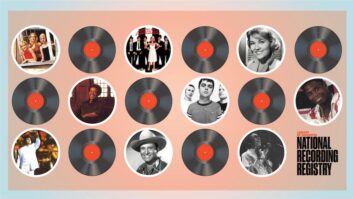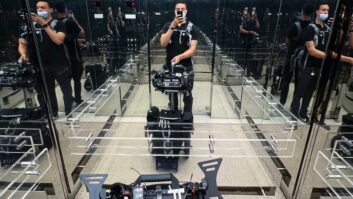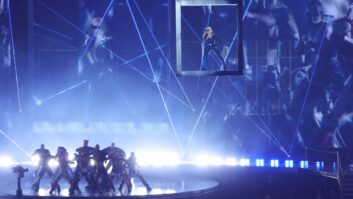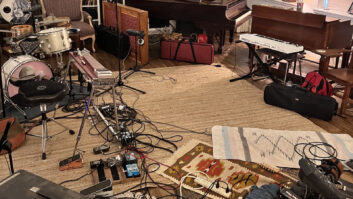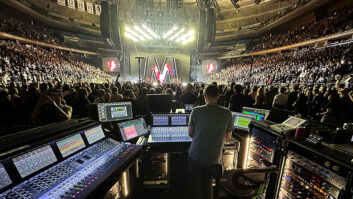In 1994, The Tractors seemed to defy the laws of Nashville. Bands were not traditionally big sellers, these guys weren’t hunkish in the least, they didn’t live in town, they produced their record themselves and didn’t hire session cats to play on it. But they still managed to take the country music world by storm. Their self-titled first album, powered by the hit “Baby Likes to Rock It,” became the fastest-selling debut by a group to go Platinum. Ultimately, it sold over 2 million copies and became the top-selling debut country album of the year. After riding that album for two years-much longer than the average country act-The Tractors began their new project in 1996. Two years later, they emerged with Farmers in a Changing World, an appropriate title for a band that is using the technology of the ’90s to craft an aesthetic rooted in the early ’50s.
“I’m not just fascinated, but obsessed, with the idea of first takes, and I use everything I can find that allows me to get closer to first takes and the energy and life that I think was in Chuck Berry records,” explains The Tractors’ leader, guitarist and engineer, Steve Ripley. “In Hank Williams’ and Chuck Berry’s days, they didn’t have any time or very many microphones, and it was the limitations that made their records great. I learned from a guy named Gene Sullivan, who wrote ‘When My Blue Moon Turns to Gold Again’ in the ’40s. He was a country star in an act called Wiley & Gene. Wiley played the fiddle and Gene played guitar and sang, and those records were recorded with one microphone, as Hank’s probably were. Mixing back then was putting the guitar player further away from the microphone. It was first or second takes, even on those history-making records. Then, everybody was playing together. Now, if you have everybody playing together, you have to go through getting the levels on 20 different microphones.
“On an old Elvis record, they might have had four or five mics,” he continues, “but most of the sound and level came from Elvis’ mic, and then Scotty Moore’s amp for the guitar was five, ten feet away from that, so really, the sound of that record is that guitar coming through Elvis’ big vocal mic. So the question is, how do you make a record that can be played alongside other modern records, and still have some of that stuff? For us, the method is to do things one at a time for the first take and the sound. Sometimes we’re playing the whole thing together, too, but if we do that, it’s for that sound and it still might be recorded with one or two microphones so you have that bleed in the room. On ‘Tulsa Shuffle Revisited’ on the first album, there were something like 14 people playing together at once-including four drummers, three guitar players, a harmonica player and a couple of B3 players-but I still recorded it with two microphones for the equivalent of one, but a stereo kind of recording of the whole room.
“The computerized hard disk recording has a cut-and-paste ability that appeals to me,” Ripley continues. “What I love most about Pro Tools is cutting one guy at a time-the J.J. Cale school of recording, where things are put on one noise at a time, almost a sculpting process. Somebody’s always got to start the tune, and in The Tractors’ case, it’s almost always me because I’m writing the song. So I’ll sketch out the shape of the song with an acoustic guitar to a Roger Linn drum machine. It’s a SMPTE-based thing, so there’s a structure which you can move things around to, including Jamie [Oldaker] when he plays the real drums, because it’s fixed with the right tempo and time structure. Almost always, we record to the Studer through the Neve [8078], and when we want to do some moving around, we put it into Pro Tools so it’s still captured as analog.
“On a couple of these songs, I put up a fresh roll of tape striped with SMPTE, so I’m listening to the drum machine for tempo. I just had a basic idea of the song and didn’t really know how the song was going to go, so I played a Martin guitar part and yelled and sang and counted through a Neumann mic. I played all the elements that might be a part of this song several times in no particular order until the tape ran off, so I ended up with a 14-minute guitar part. I got to go free-form and experience it like it was the first time I heard it, too, and I dumped that into Pro Tools and went back and cut them together, sort of finishing the writing of the song after I had played. You end up with energy and spirit and life, which is the opposite from the mathematical approach of when you know how the song goes and you’re trying not to make a mistake.”
Obviously this is not the typical Nashville recording method. But then again, they’re not in Nashville. The Tractors all live in Oklahoma and record at Church Studio in Tulsa, a facility with a long history that links it to Ripley. It began with Ripley’s discovery of Leon Russell:
“I was in college at Oklahoma State University, which was about an hour and a half away from Tulsa, when I saw a poster for a Leon Russell/Joe Cocker and Mad Dogs & Englishmen concert,” Ripley recalls. “Anyone lucky enough to have been at that concert at the Brady Theater must remember it. It was right then that I discovered that Leon Russell was from Tulsa. Imagine the impact of finding out a hero is one of your own, so to speak. It was a big night.”
He had no way of knowing how intertwined his life would become with Russell’s. In the early ’70s, Russell opened Shelter Records along with a fine old studio built in a converted church in Tulsa. Just as the tapes Ripley had made on his 8-track Ampex one-inch machine in Stillwater attracted attention at the label, Shelter closed its doors. But it wasn’t the end of contact with Russell. After a brief attempt at songwriting with his wife in Nashville, Ripley moved back to Oklahoma in 1976 and took a job as Russell’s monitor mixer.
“That’s the most thankless job in the universe,” Ripley says. “The monitors were never right. It was a huge band. Gary Busey was playing drums with two other drummers, there were background singers and a stage full of people, which is really great, but we had a cheesy P.A. system that I had to make work. Leon actually threw an SM57 at me one night from across the stage during a show because he was angry at me for something that wasn’t my fault. I can see him now, waving the background singers, who were between me and him, out of the way, so he could throw that SM57. It was just like a cartoon. I was shocked as it came right at my head, but the cord ran out like the dog on the chain, and it fell down on my monitor mixer about two feet from my face. Then I remember one night as we were packing up, he was walking down below the stage to the bus. We still hadn’t really met yet, and he looked up and said, ‘You’ll get it right someday, Mickey Monitor.'”
Eventually Russell came to appreciate Ripley’s talents, and when Shelter moved to L.A., Ripley was brought out to work as Russell’s recording engineer. The experience was invaluable. “The greatest moments were while I was placing mics with my head up under the lid of the Steinway that Leon was playing,” Ripley says. “Going back to the control room to try to get that on tape was always my goal. I loved that natural left to right, low to high stereo spread where the piano was centered and the drums spread out left to right-mostly from just direct overheads so you also hear just the way the drummer is sitting at his drum throne-and a Leslie on a B3, miked from different sides.”
As a sideline during his tenure working with Russell, Ripley invented a unique 6-channel guitar. When the momentum of Russell’s career stopped due to the pianist’s financially complicated divorce, Ripley switched gears and became a full-time luthier. He made guitars for such virtuosos as J.J. Cale, Steve Lukather and Eddie Van Halen. “I don’t regret the time I spent doing that because it was the best excuse to meet my guitar heroes,” Ripley says with a laugh.
Then one day, out of nowhere, Ripley’s friend (now a successful country video director) Sherman Halsey was listening to one of the tapes Ripley had made and said, “I don’t know, it sounds like The Tractors to me.”
“I don’t know where that came from, but it then became my goal to get back to Oklahoma to do this band called The Tractors,” Ripley says. Over time he put together a group consisting of Walt Richmond, who had played keyboards for Bonnie Raitt and Rick Danko; guitarist Ron Getman, who had toured with Janis Ian and Leonard Cohen; bassist Casey VanBeek, who had worked with Linda Ronstadt; and Jamie Oldaker, who had provided the backbeat for Eric Clapton for many years. Then, lo and behold, Church Studio went up for sale. Ripley and the boys found themselves in the building that Ripley had once used to ride by just to see whose car was parked there.
They began the first Tractors record on an MCI 24-track and MCI J-600 console. As soon as they signed a record deal, though, they bought a Neve 8068 and a Studer multitrack that was refurbished by Fred Hill.
“The people we bought the studio from had put in a modern control room with angled walls and all that stuff,” Ripley says. “We ripped that out and we found Leon’s control room box sandwiched in between their two walls and we put the control room back to the way it used to be in the old church days, which is hardwood floors and brick walls with enough sound absorption stuff to suck out some of the noise. It’s not a very proper control room. It’s got lots of windows, and you can open them up if you want to let the air blow through. The control room is fairly good size, but Leon also added a tape room, which must have been a classroom in the old days. That’s all one big room now, so it’s pretty big and we have one of the Steinways in there, and the tape machines. It’s big enough to put a drum kit up in it if you want, because it’s all brick walls and windows and hardwood floors, so it’s real live.
“The big room is the sanctuary, which is pretty much as Leon left it, although he deadened it up probably a little too much. We left the hardwood floors in the big room, and the vibe of it is astonishing.”
Ripley spends an inordinate amount of time in the studio playing music, engineering and doing his own maintenance work. “When we need more mic cords, I tend to be the guy to solder them, so I might spend the day making mic cords or guitar cords, or hooking up the speaker wire or building a headphone system,” he says. “We don’t have a factory up the street, and we’re poor boys, too. So we’re not about to fly everything in that we need. Besides, it helps us to be more Tractor-ish and homegrown.”
It’s not surprising that Ripley is a fan of vintage gear, from Neumann mics to Pultecs. Ripley calls himself a Neumann 47 and 48 fanatic and notes, “Every time I see a great old picture of one of my favorite artists, they’re singing through one of those two microphones. It’s the Beatles mic, it’s the Johnny Cash mic, it’s the Frank Sinatra mic-it never got better than that. With three of those mics, we’re able to put the background vocals on all at once, which is what we do together with Casey, Ron and Walt. So that all the jiving, laughing, joking, snorting and spittin’ happens at one time. Then I have a selection of other tube Neumanns-54s, 64s and 86s. I do a lot of the acoustic guitar and dobros through those 54s and 56s.
“We use the Neve console, and those Neve preamps and EQs are really great,” he continues. “I like three different preamps-a solid-state one made by GML, the Manley tube preamp, which I use quite a bit, and a D.W. Fearn, which is a great big tube preamp that’s based on the old RCA design. I don’t want to be such a tube fanatic that I go for tube even if it doesn’t sound as good as solid state, just because it’s tube. That’s a silly position to be in. In terms of preamps, the Neves certainly sound great, and, of course, they’re transistor and the GML is also. I have a few channels of API preamps and EQs, and I have about 30 or 40 channels of Telefunken tube preamps that are being refurbished.
“The creative process isn’t just the three-minute song,” Ripley says of his passion for the entire recording process. “It’s literally making the cords you’re going to use on the microphones and deciding what microphone and amp you’re going to use. It’s all part of the process down to that final moment where I have to turn it loose and send it off to the manufacturing process. Everything is part of the deal-how it’s going to sound and what zone you’re in when you’re singing it. There’s stuff in the air any given day. Ron played an old Gretsch lap steel-the precursor to steel guitars-which he had never played before. We plugged it into a random amp, turned it up real loud and he played the solo. We were thinking, ‘That can’t be it,’ but he played great solo after great solo all day long and the next day, and eventually we went back to the first one, which happens over and over again. That’s the screaming slide sort of solo on the first song on the album, ‘I Wouldn’t Tell You No Lie.'”
The album ends with “Foot Stomp Stompin'” and a full-circle moment: Leon Russell recording at Church Studio with Ripley and the group. Ripley says he just let the tape roll, a practice he learned from working with Russell and nearly being fired for forgetting a few times. “The only reason he was there playing that Steinway is because of the buddy thing,” Ripley states. “He doesn’t normally overdub or play old-fashioned acoustic piano anymore, but I set up the tape and got it ready, and he knew at some point he’d have to play or go home,” Ripley laughs. “He had never heard the song before and he got it in the first take, and at the end, I didn’t shut the tape off, and sure enough, he came through for me-he noodled around and sang, ‘There’s a Tractor tugging at my heart.’ Then he says, ‘What now, Steve?'” The perfect ending to a perfectly imperfect record.

